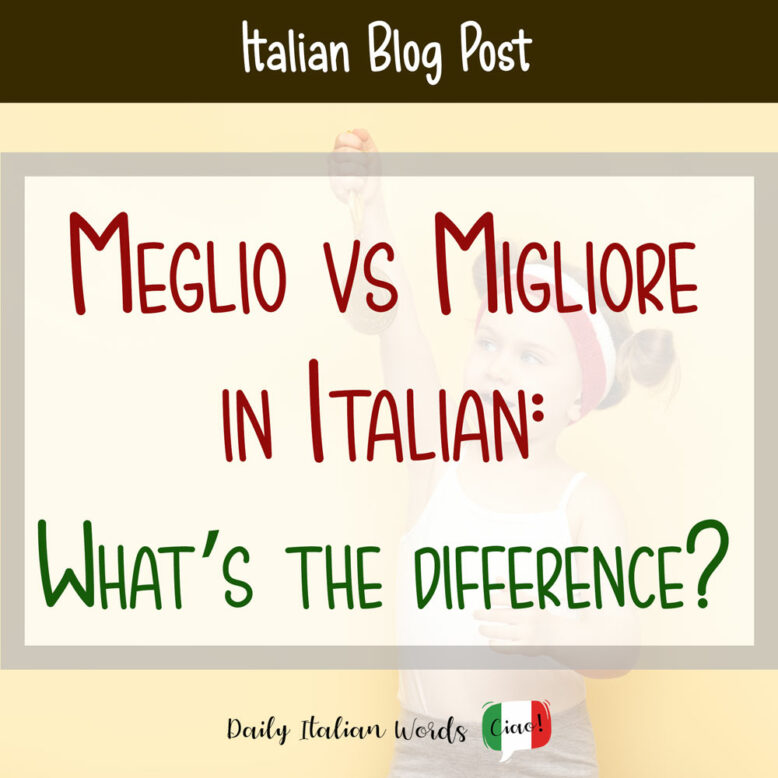Italian learners can easily get confused regarding the use of the words meglio and migliore. Indeed, both can be translated with the words “better” and “best”.
When you learn these words in Italian, you should also be careful about the role the words have in the sentence (adverb, adjective or noun). Based on this, you can produce a more accurate translation to English.
In this post, we will treat the topic in depth to help you improve your Italian grammar skills.

How to use “meglio”
Meglio is the comparative of the adverb bene (“well”) and, as an adverb, it follows verbs and is invariable, so it never becomes masculine or feminine, singular or plural.
Meglio is sometimes used with the meaning of “in a better way”. Here are some examples:
Con questi nuovi occhiali vedo molto meglio.
I can see much better with these new glasses.
Giovanni sa cantare meglio di Paolo.
Giovanni can sing better than Paolo.
You can also find this adverb in some Italian sayings: Di bene in meglio, which can be translated as “from good to better”, meaning a rapid and continuous improvement, and Per meglio dire, which can be translated as “better to say” and is used to clarify or correct a previous statement. Avere la meglio (su) means to prevail, to impose or to triumph over someone or something.
Meglio can also be used to express satisfaction or complacency. Let’s see an example:
Non sono a casa? Meglio!
They aren’t at home? All the better!
Note that you can include the adverb così (like this) to add extra emphasis to the phrase above (Meglio così!).
Meglio can also be used as an adjective, with verbs like sembrare (to seem), essere (to be), parere (to appear) followed by the preposition di (than).
Questo vino mi sembra meglio dell’altro.
This wine seems better than the other one.
You’ll also see it used with the comparative che (than):
Meglio tardi che mai.
Better late than never.
Finally, meglio can be used as a noun with the meaning of “the best (thing)” in sentences like:
È il meglio sul mercato.
It is the best (thing) on the market.

How to use “migliore”
Migliore is the comparative of the adjective buono when it means “good”. Being an adjective, it is used in conjunction with a noun and can be singular, plural, masculine or feminine.
More specifically, the migliore form is invariable for the masculine and the feminine, while for the plural it becomes migliori for both genders. Sometimes migliore is written without the final e when it is followed by a noun starting with a vowel (e.g. il mio miglior amico = my best friend).
Migliore is used in comparative sentences with the meaning “better than” in English, both alone and with a noun:
Questa giacca è migliore dell’altra.
This jacket is better than the other one.
Questa giacca ha un tessuto migliore di quella di Paola.
This jacket has a better fabric than Paola’s.
However, be careful because the comparative is different for the meaning “kind / nice” or “yummy / tasty” of buono: in that case, Italians use più buono. For example:
Luca è più buono di Paolo.
Luca is kinder/nicer than Paolo.
Il gelato alla fragola è più buono di quello al cioccolato.
The strawberry ice cream is tastier than the chocolate one.
Migliore is also used as the relative superlative when it is preceded by definite articles (il, lo, la, i, gli, le). In other words, it can sometimes be translated as “best”. Let’s see some examples, with and without the comparative preposition di:
Luca è il mio migliore amico.
Luca is my best friend.
Roma è la città migliore del mondo.
Rome is the best city in the world.

Spoken Italian: Meglio vs migliore
Despite what has just been said, in spoken Italian people tend to use the adverb meglio instead of migliore, especially when they make comparisons using the verbs essere, sembrare, parere and the like.
Let’s see a couple of cases in which you will often hear Italians say meglio in the place of migliore, despite the latter being the more grammatically correct choice:
La Coca Cola è meglio della Pepsi secondo i miei amici.
Coke is better than Pepsi according to my friends.
Roma è meglio di Milano se ami la storia.
Rome is better than Milan if you like history.
Has this cleared up some confusion about the differences between meglio and migliore? We certainly hope so!
Heather Broster is a graduate with honours in linguistics from the University of Western Ontario. She is an aspiring polyglot, proficient in English and Italian, as well as Japanese, Welsh, and French to varying degrees of fluency. Originally from Toronto, Heather has resided in various countries, notably Italy for a period of six years. Her primary focus lies in the fields of language acquisition, education, and bilingual instruction.


